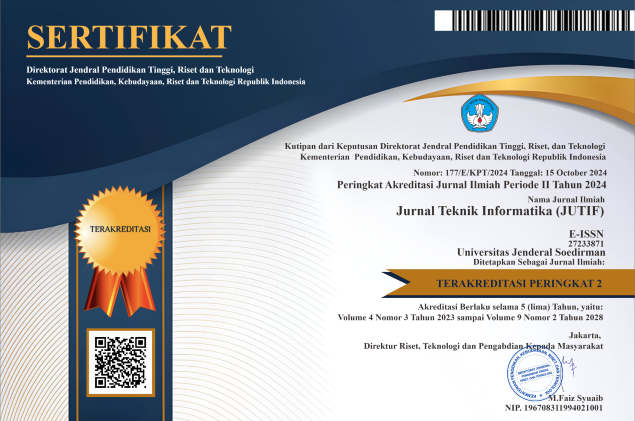Utility-Based Buffer Management for Enhancing DTN Emergency Alert Dissemination in Jakarta's Urban Rail Systems
DOI:
https://doi.org/10.52436/1.jutif.2025.6.4.5241Keywords:
Buffer Management, DTN, Drop Policy, Emergency Alert, Utility BasedAbstract
The efficiency of emergency alert dissemination in highly populated and densely urban transport networks, such as Jakarta's integrated rail system, is undermined by sporadic connectivity and limited network resources. In this environment, an initial comparison of baseline Delay-Tolerant Network (DTN) routing protocols revealed that flooding-based routers, such as Epidemic, while achieving above-average delivery rates, suffered from high overhead and poor buffer utilization. This paper fills this gap by proposing the Combined Utility Router, a novel buffer management policy that overcomes the limitations of naive strategies, such as Drop-Oldest. Our approach holistically evaluates a message's value by assigning a weighted utility function based on its Time-To-Live (TTL), estimated total replicas, message size, and a user-defined priority. The router maintains high-value messages by discarding the message deemed the lowest utility score under the buffer constraint. Utility-based simulations in The ONE simulator demonstrate that applying our approach to Epidemic routing improves delivery probability, reduces average latency in high network congestion scenarios, while maintaining overhead rates. This work confirms that, in the context of developing reliable and efficient emergency communication systems for challenging urban topographies, optimizing buffer management extends beyond simply selecting the appropriate protocol.
Downloads
References
R. Martinez and I. N. Masron, “Jakarta: A city of cities,” Cities, vol. 106, no. 102868, p. 102868, Nov. 2020, doi: https://doi.org/10.1016/j.cities.2020.102868.
R. Oktorini and L. Sari Barus, “Integration of Public Transportation in Smart Transportation System (Smart Transportation System) in Jakarta,” Konfrontasi: Jurnal Kultural, Ekonomi dan Perubahan Sosial, vol. 9, no. 2, pp. 341–347, Jun. 2022, doi: https://doi.org/10.33258/konfrontasi2.v9i2.223.
National Academies of Sciences, Engineering, and Medicine, Emergency Alert and Warning Systems. Washington, D.C.: National Academies Press, 2018. doi: https://doi.org/10.17226/24935.
B. Ravaei, K. Rahimizadeh, and A. Dehghani, “Intelligent and hierarchical message delivery mechanism in vehicular delay tolerant networks,” Telecommunication Systems, vol. 78, May 2021, doi: https://doi.org/10.1007/s11235-021-00801-1.
C. Chakrabarti and Samir Pramanick, “Implementing Data Security in Delay Tolerant Network in Post-disaster Management,” Lecture notes in electrical engineering, pp. 77–92, Oct. 2021, doi: https://doi.org/10.1007/978-981-16-4035-3_8.
W. Khalid, N. Ahmed, S. Khan, Z. Ullah, and Y. Javed, “Simulative Survey of Flooding Attacks in Intermittently Connected Vehicular Delay Tolerant Networks,” IEEE Access, vol. 11, pp. 75628–75656, Jan. 2023, doi: https://doi.org/10.1109/access.2023.3297439.
M. Matracia, N. Saeed, M. A. Kishk, and M.-S. Alouini, “Post-Disaster Communications: Enabling Technologies, Architectures, and Open Challenges,” IEEE Open Journal of the Communications Society, vol. 3, pp. 1177–1205, 2022, doi: https://doi.org/10.1109/ojcoms.2022.3192040.
A. Agussalim, I. Gede, E. Adi Saputro, M. Idhom, A. N. Sihananto, and S. Mukarromah, “Exploring Store-Carry-forward Networking on Emergency Alert Dissemination of Jakarta’s Integrated Rail System,” pp. 363–368, Nov. 2024, doi: https://doi.org/10.1109/itis64716.2024.10845704.
S. Singh and A. Verma, “Buffer Management Techniques in Delay Tolerant Networks: A
Comprehensive Survey,” Recent Advances in Computer Science and Communications, vol. 16, no. 8, Oct. 2023, doi: https://doi.org/10.2174/2666255816666230817101831.
O. Ur Rehman, I. Ahmed Abbasi, H. Hashem, K. Saeed, M. Faran Majeed, and S. Ali, “SS-Drop: A Novel Message Drop Policy to Enhance Buffer Management in Delay Tolerant Networks,” Wireless Communications and Mobile Computing, vol. 2021, pp. 1–12, Jun. 2021, doi: https://doi.org/10.1155/2021/9773402.
S. Khan, K. Saeed, M. Faran Majeed, S. A. AlQahtani, K. Aurangzeb, and M. Shahid Anwar, “NPBMT: A Novel and Proficient Buffer Management Technique for Internet of Vehicle-Based DTNs,” Computers, materials & continua/Computers, materials & continua (Print), vol. 77, no. 1, pp. 1303–1323, Jan. 2023, doi: https://doi.org/10.32604/cmc.2023.039697.
A. Prasad, S. Gurung, and K. Sharma, “Challenges and opportunities to Enhance Buffer Management for Disaster Area in Delay Tolerant Network: A Review with Performance Analysis,” 2024 International Conference on Electrical Electronics and Computing Technologies (ICEECT), pp. 1–9, Aug. 2024, doi: https://doi.org/10.1109/iceect61758.2024.10739286.
S. Rashid and Q. Ayub, “Social Community Buffer Management Policy for Delay Tolerant Network,” Wireless Personal Communications, vol. 130, no. 3, pp. 2099–2120, Apr. 2023, doi: https://doi.org/10.1007/s11277-023-10373-9.
A. Balasubramanian, B. Neil Levine, and A. Venkataramani, “DTN routing as a resource allocation problem,” Aug. 2007, doi: https://doi.org/10.1145/1282380.1282422.
Agussalim, A. Pratama, E. M. Safitri, N. C. Wibowo, and A. B. Putra, “Message Time-to-live based Drop Policy Under Spray and Hop Distance Routing,” IEEE Xplore, Oct. 01, 2020. https://ieeexplore.ieee.org/abstract/document/9321110 (accessed Sep. 13, 2023).
S. Hasan, M. Sharifi Sani, S. Iranmanesh, A. H. Al-Bayatti, S. Khan, and R. Raad, “Enhanced Message Replication Technique for DTN Routing Protocols,” Sensors, vol. 23, no. 2, p. 922, Jan. 2023, doi: https://doi.org/10.3390/s23020922.
S. Iqbal, I. A. Choudhry, and A. M. Lodhi, “Intelligent Buffer Management Policy in Post Disaster Network Using DTN,” 2023 25th International Multitopic Conference (INMIC), pp. 1–8, Nov. 2023, doi: https://doi.org/10.1109/inmic60434.2023.10465769.
E. Rosas, O. Andrade, and N. Hidalgo, “Effective communication for message prioritization in DTN for disaster scenarios,” Peer-to-Peer Networking and Applications, Dec. 2022, doi: https://doi.org/10.1007/s12083-022-01416-2.
M. Gurmessa, Y. Negesa, and S. Nagarajan, “Comparative Analysis of Simbet with Ttl and Simbet with Social Based Message Dropping Policy Routing Protocol,” SSRN Electronic Journal, Jan. 2023, doi: https://doi.org/10.2139/ssrn.4385650.
Y. Harrati and A. Abdali, “MaxHopCount: A New Drop Policy to Optimize Messages Delivery Rate in Delay Tolerant Networks,” International Journal of Interactive Multimedia and Artificial Intelligence, vol. 4, no. 1, pp. 37–37, Jan. 2016, doi: https://doi.org/10.9781/ijimai.2016.417.
Agussalim and M. Tsuru, “Spray Router with Node Location Dependent Remaining-TTL Message Scheduling in DTNs,” Journal of information processing, Jan. 2016, doi: https://doi.org/10.2197/ipsjjip.24.647.
F. Rashidjafari, N. Derakhshanfard, B. Shahrokhzadeh, and A. Ghaffari, “Selfish Node Detection in Delay Tolerant Networks Using Fuzzy Logic,” Fuzzy Information and Engineering, vol. 16, no. 4, pp. 285–299, Dec. 2024, doi: https://doi.org/10.26599/fie.2024.9270046.
N. Sonkar, S. Darshan SL, and S. Acharekar, “Enhancing Multihop Routing in DTNs via Fuzzy Logic-Driven Relay Selection Mechanisms,” pp. 1–6, Apr. 2025, doi: https://doi.org/10.1109/otcon65728.2025.11070422.
J. Wu, F. Yuan, Y. Guo, H. Zhou, and L. Liu, “A Fuzzy‐Logic‐Based Double Q‐Learning Routing in Delay‐Tolerant Networks,” Wireless Communications and Mobile Computing, vol. 2021, no. 1, Jan. 2021, doi: https://doi.org/10.1155/2021/8890772.
A. Keränen, J. Ott, and T. Kärkkäinen, “The ONE simulator for DTN protocol evaluation,” Proceedings of the Second International ICST Conference on Simulation Tools and Techniques, 2009, doi: https://doi.org/10.4108/icst.simutools2009.5674.
P. Garg, H. Kumar, R. Johari, P. Gupta, and R. Bhatia, “Enhanced Epidemic Routing Protocol in Delay Tolerant Networks,” pp. 396–401, Feb. 2018, doi: https://doi.org/10.1109/spin.2018.8474132.
Additional Files
Published
How to Cite
Issue
Section
License
Copyright (c) 2025 Agussalim, Nguyen Viet Ha, Handie Pramana Putra, Ma’ratul Adila, I Gede Susrama Mas Diyasa, Basuki Rahmat

This work is licensed under a Creative Commons Attribution 4.0 International License.



























